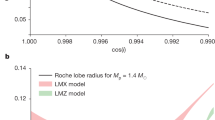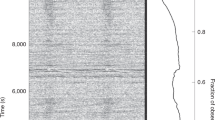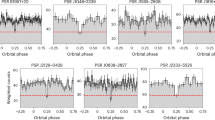Abstract
The recently discovered1 1.6 ms binary radio pulsar PSR1957 + 20 shows radio eclipses whose duration indicates that the occulting body is substantially larger than the Roche lobe of the low-mass (∼10–2M⊙) companion star. This suggests1–4 that this companion is evaporating through the action of a strong pulsar energy flux5. An optical counterpart has been detected which shows brightness variations in phase with the 9.2 h orbital cycle6. We have obtained optical charge coupled device (CCD) images which show that the counterpart is one component of a close visual pair separated by ∼0.7 arcsec. At maximum both are equally bright with combined V magnitude of 19.9, while at minimum PSR1957 + 20 is invisible. From spectroscopic observations we find that the contaminating star is a normal G star. The spectrum of PSR1957 + 20 shows intermittent Hα emission. We confirm that the optical brightness of PSR1957 + 20 varies in phase with the radio Doppler velocity curve1, and find that the amplitude is probably more than 3 magnitudes, minimum light coinciding with the radio eclipse. The optical light curve is consistent with heating of a hydrogen-rich low-mass white dwarf by high-energy radiation from the nearby millisecond pulsar.
This is a preview of subscription content, access via your institution
Access options
Subscribe to this journal
Receive 51 print issues and online access
$199.00 per year
only $3.90 per issue
Buy this article
- Purchase on SpringerLink
- Instant access to full article PDF
Prices may be subject to local taxes which are calculated during checkout
Similar content being viewed by others
References
Fruchter, A. S., Stinebring, D. R. & Taylor, J. H. Nature 333, 237–239 (1988).
Phinney, E. S., Evans, C. R., Blandford, R. D. & Kulkarni, S. R. Nature 333, 832–834 (1988).
Van den Heuvel, E. P. J. & van Paradijs, J. Nature 334, 227–228 (1988).
Kluzniak, W., Ruderman, M., Shaham, J. & Tavani, M. Nature 334, 225–227 (1988).
Ruderman, M., Shaham, J. & Tavani, M. Astrophys. J. (in the press).
Fruchter, A. S. et al. IAU Circular No. 4617 (1988).
Allington-Smith, H., Breare, M., Ellis, M., Gray, P. & Worswich, S. WHT FOS User Manual (Royal Greenwich Observatory, 1988).
Oke, J. B. Astrophys. J. Suppl. 27, 21–35 (1974).
Stetson, P. B. Publ. astr. Soc. Pacif. 99, 191–222 (1987).
Manchester, R. N. & Taylor, J. H. Astr. J. 86, 1953–1973 (1981).
Lyne, A. G., Manchester, R. N. & Taylor, J. H. Mon. Not. R. astr. Soc. 213, 613–639 (1985).
Neckel, Th. & Klare, G. Astr. Astrophys. Suppl. 42, 251–281 (1981).
Weaver, H. & Williams, D. R. W. Astr. Astrophys. Suppl. 17, 1–249 (1975).
Dame, T. M. et al. Astrophys. J. 322, 706–720 (1987).
Savage, B. D. & Mathis, J. S. A. Rev. Astr. Astrophys. 17, 73–111 (1979).
Popper, D. A. Rev. Astr. Astrophys. 18, 115–164 (1980).
Van Paradijs, J. in Accretion-driven Stellar X-ray Sources (ed. Lewin, W. H. G. & van den Heuvel, E. P. J.) 189–260 (Cambridge University Press, 1983).
Zapolsky, H. S. & Salpeter, E. E. Astrophys. J. 158, 809–812 (1969).
Backer, D. C., Kulkarni, S. R., Heiles, C., Davis, M. M. & Goss, W. M. Nature 300, 615–618 (1982).
Kippenhahn, R. & Thomas, H.-C. Astr. Astrophys. 75, 281–290 (1979).
Kuiper, L., van Paradijs, J. & van der Klis, M. Astr. Astrophys. (in the press).
Author information
Authors and Affiliations
Rights and permissions
About this article
Cite this article
van Paradijs, J., Allington-Smith, J., Callanan, P. et al. Optical observations of the eclipsing binary radio pulsar PSR1957 + 20. Nature 334, 684–686 (1988). https://doi.org/10.1038/334684a0
Received:
Accepted:
Published:
Issue Date:
DOI: https://doi.org/10.1038/334684a0



